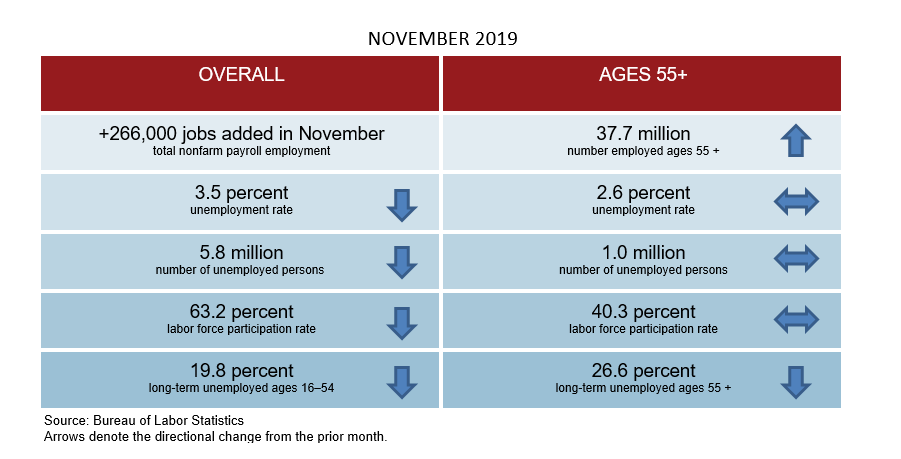AARP Hearing Center
Economy Adds 266,000 Jobs in November; Number of Unemployed Ages 55+ Remain Unchanged
By Jennifer Schramm, January 13, 2020 01:39 PM

Employment Overview
November showed strong job growth, with the economy adding 266,000 jobs, up from 156,000 jobs added in October (revised up from +128,000), according to the Bureau of Labor Statistics (BLS) monthly Employment Situation Summary. The overall unemployment rate edged down to 3.5 percent and remained at 2.6 percent for those ages 55 and older. The number of people ages 55+ who were unemployed also remained unchanged at 1.0 million, while the number employed in this age group edged up to 37.7 million. The overall labor force participation rate declined slightly to 63.2 percent and remained at 40.3 for those ages 55+ for the fourth consecutive month. In November, 26.6 percent of jobseekers ages 55+ were long-term unemployed (looking for work for 27 weeks or longer) compared with 19.8 percent of those ages 16 to 54.
Spotlight on How Unemployment is Measured
Given the abundance of available government data relating to the labor market, confusion among the public about how the government measures and tracks unemployment is understandable.
A common misconception about unemployment measurement is that the government uses the number of people collecting unemployment insurance (UI) benefits under state or federal government programs to come up with the monthly number of unemployed. However, because some people continue to be out of work even when their benefits run out, and even more people are not eligible for UI or delay or never apply for it, using this measure would not be an accurate way to track unemployment. Instead, the government conducts a monthly survey, the Current Population Survey (CPS), which asks a range of work-related questions. Among these are questions about labor market participation, retirement status, active job-seeking behaviors, and more.
The CPS includes six measures of “labor underutilization,” but only one of these is designated as the official unemployment rate. These measures go from the narrowest, U-1, which is the percentage of the labor force unemployed 15 weeks or longer, to the broadest, U-6, which combines the total unemployed, total employed part-time for economic reasons, and all persons marginally attached to the labor force. The official unemployment rate, U-3, is the percentage of the labor force that is unemployed—defined as individuals that do not have a job, but have actively looked for work in the prior four weeks and are currently available for work.
Even among economists, debate continues about how accurately the standard unemployment rate portrays the realities of today’s labor market, especially for older people, and whether some individuals that are considered “not in the labor market” should instead be considered unemployed. Because many people ages 55 and older are not in the labor market, these questions can be particularly relevant for this age group, prompting some economists to develop additional measures that also take into account factors such as involuntary retirement.
A clearer picture of the labor market experience of older workers and jobseekers emerges when considering other data such as duration of unemployment; older workers tend to be out of work longer and experience long-term unemployment more often than their younger counterparts do. And, giving credence to those who believe unemployment among older workers is underreported, efforts to collect cohort data, or mine other data sources have indeed shown a more harrowing view of the labor market for older workers than the low monthly unemployment rates for those ages 55 and older might suggest.
Find more details on the latest employment data in the November Employment Data Digest, the AARP Public Policy Institute's (PPI) monthly review of job trends for those ages 55 and over. For more data to drive policy solutions, go to PPI's Data Explorer, and for information on skills, jobs, and occupations for the 50+, visit AARP's skills shortage data tool.

Jen Schramm is a senior strategic policy advisor at the AARP Public Policy Institute. Her areas of expertise include employment trends, policy challenges, and opportunities related to workers and jobseekers ages 50 and above, and skills and credentialing for mid- and late-career workers.































































